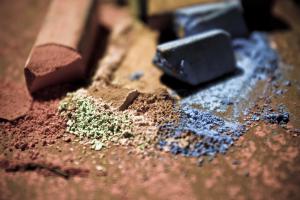Italian Renaissance Unit Study
Giotto di Bondone (1266-1337)
Michelangelo Buonarroti (1475-1564)
Leonardo da Vinci (1452-1519) – coming soon
Raphael (1483 – 1520) – coming soon
Teacher’s Tip: Artists often use nude figures or other content that could be upsetting or confusing for children. I recommend you prescreen any websites or other materials you plan to use with your children or students. Know how you will approach these artworks and answer any questions the children might have. If you are teaching a class, be aware that every family has different guidelines of what they find appropriate.
Giotto di Bondone (1267-1337)
Listen to the pronounciation.
- Generally considered to be the first Renaissance painter
- Masterwork is the decoration of the Scrovegni Chapel in Padua, or Arena Chapel.
- Giotto’s paints were made from egg yolks mixed with minerals, clay, ground insects, or berries.
- Learned to make paintbrushes and art tools.
- See links below for more information.
Activity: Make your own egg tempera. Paint with the egg tempera.
Materials:
- Colored chalk or powdered tempera
- Egg
- Water
- Old muffin tin
- Bowl or plate
- Heavy object for grinding (e.g., cup, rock)
- Heavy paper for painting
- Paint brush
- Paper towels
Directions:
- If you are using chalk, grind it into a powder using the bowl or plate and heavy object.
- Place different colors of the powdered chalk or tempera each in a cup of the muffin tin.
- Separate the egg yolk from the white.
- Mix the egg yolk well with a teaspoon of water.
- Add the egg yolk mixture a spoon at a time to the colored powder and stir. Add water if needed.
- You’re ready to paint! Allow children to make what they want, a portrait, or recreate one of Giotto’s masterworks.
Links:
Background information: http://www.giottodibondone.org/ http://www.artble.com/artists/giotto_di_bondone
Egg tempera: http://www.incredibleart.org/files/tempera.htm http://ahandmadechildhood.blogspot.com/2010/03/how-to-make-egg-tempera-paint.html
Other Activities: http://www.ehow.com/info_8316297_giotto-classroom-activities.html http://www.gardenofpraise.com/art17.htm Scroll to the bottom of the page to see links to online AND printable worksheets, puzzles, and a multiple-choice test.
 Michelangelo Buonarroti (1475-1564)
Michelangelo Buonarroti (1475-1564)
Listen to the pronounciation.
- Born in Caprese, Italy
- Renaissance sculptor, painter, architect, poet, and engineer
- Most famous sculptures included the statues of David (18-foot tall!) and Pietà. His most famous paintings are the ceiling of the Sistine Chapel and also “The Last Judgement.”
- See links below for more information.
Activity: Simulate Michelangelo’s painting of the Sistine Chapel by creating a painting overhead.
- Background: For four years (1508-1512), Michelangelo painted the ceiling of the Sistine Chapel. He painted from platforms that were 60 feet in the air. Contrary to popular belief, Michelangelo did not paint lying down. However, he often had to bend backwards and paint over his head. The painting is called a fresco because it is painted on plaster, usually on a wall or ceiling.
- Teacher’s Tip: If you can find a way for children to safely stand and paint over their heads, go for it! Otherwise, children can get an idea of what it was like by sitting on the floor and painting paper taped to the bottom side of a table.
- Picture Suggestions: You may choose to trace the outline of a Sistine Chapel scene for children to paint. Other options include having children paint their favorite Bible scene or their favorite scene from the Sistine Chapel.
Materials:
- Newspapers
- Optional: Pictures of the Sistine Chapel or picture Bibles
- Heavy paper for painting
- Non-toxic acrylic or tempera paint
- Paint brushes
- Masking tape
- Cups of water
- Paper towels
Directions:
- Place newspapers under the table.
- Tape a sheet of heavy paper to the bottom of the table for each child.
- Children paint their favorite Bible scene, portion of the Sistine Chapel, or paint the outline you provided.
- How would you feel if you had to paint like this for four years? Instead of the floor, Michelangelo was on top of scaffolding that was sixty feet in the air!
Links:
Background information: http://www.michelangelo.com/buonarroti.html http://arthistory.about.com/cs/namesmm/a/michelangelo.htm http://artsmarts4kids.blogspot.com/2007/09/artist-profile-michelangelo.html
Kids page: http://makingartfun.com/htm/f-maf-art-library/michelangelo-biography.htm
Sistine Chapel ceiling: http://arthistory.about.com/od/famous_paintings/a/sischap_ceiling.htm http://artsmarts4kids.blogspot.com/2007/09/michelangelos-sistine-chapel-ceiling.html https://en.wikipedia.org/wiki/Sistine_Chapel_ceiling
Other activities: http://www.gardenofpraise.com/art50.htm Scroll to the bottom of the page to see links to online AND printable worksheets, puzzles, and a multiple-choice test.
Premium links (fee required):
BrainPOP: http://www.brainpop.com/artsandmusic/artistsandmusicians/michelangelobuonarroti/preview.weml

